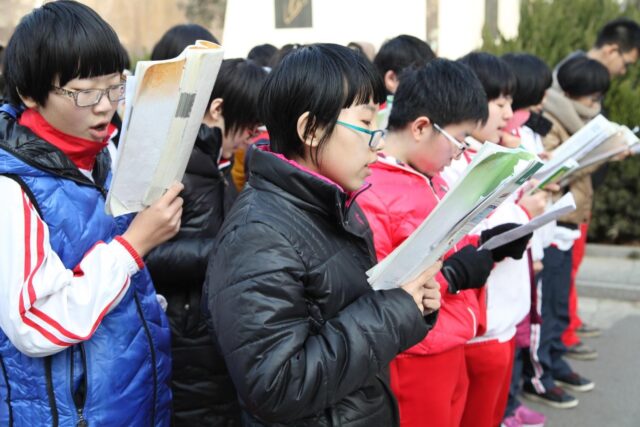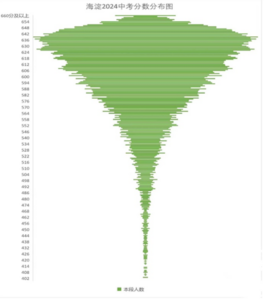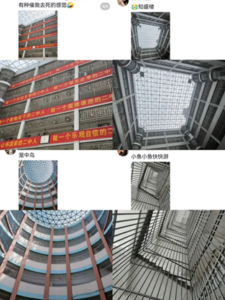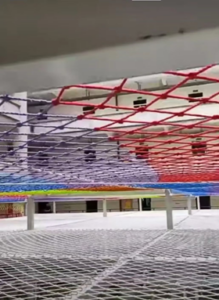
From Ambition to Anxiety: The Unraveling of Xi Jinping’s Vocational Education Policy
Publication: China Brief Volume: 24 Issue: 23
By:

Executive Summary:
- Xi Jinping’s vocational education reforms, designed to address a skills gap, have been distorted at the local level, with uneven implementation and coercive measures intensifying stress on students.
- The centralized power structure of the People’s Republic of China (PRC) incentivizes local officials to prioritize compliance over effective reform, resulting in rigid enforcement and negative societal impacts.
- The reforms have exacerbated an emerging mental health crisis among students, deepening dissatisfaction and exposing systemic flaws in the PRC’s governance model.
“Fight on, students of Dazhu Middle School, oppose authoritarian rule (战斗起来,竹中学子们,反对专制统治).” This protest slogan appeared on a sign written by students at Dazhu Middle School (大竹中学) in Sichuan in early November. The students were speaking out against strict school regulations, such as only having a 40-minute lunch break and an afternoon campus lockdown. Some even waved Chinese Communist Party (CCP) flags in protest (X.com/@whyyoutouzhele, November 11). School protests are not uncommon. In September, a ban on female students having long hair sparked widespread discussion. In one case, a school that had previously enforced this rule relaxed its policy to allow long hair, but only in one very specific style. Rules remain strict otherwise, with no “strange (怪异)” hairstyles allowed (Netease News, 19 September).
Student protests and debates over school rules highlight a stark contrast between the central government’s policy intentions and the harsh realities of policy implementation at the grassroots level. Seemingly well-intentioned policies are often distorted upon execution, as local officials, incentivized by the CCP’s rigid performance metrics, prioritize compliance and measurable outcomes over the nuanced needs of those impacted. This dysfunction is a feature, not a bug, of the political structure under CCP General Secretary Xi Jinping’s leadership, where the space for honest feedback is suppressed, and alternative perspectives are often sidelined. In such a system, meaningful policy discourse and adjustments become virtually impossible.
Xi’s reforms to vocational education (职业教育), initially designed to address a national skills gap, exemplify this dynamic. These policies, intended to create a skilled workforce for emerging industries, have instead led to coercive measures and overly rigid implementation that disregard the needs and experiences of students, parents, and educators. The lack of genuine feedback has transformed what should have been an empowering reform into a source of widespread anxiety and social tension. Rather than alleviating stress, the vocational education reforms have magnified it, reflecting deeper structural issues embedded in the governance of the People’s Republic of China (PRC).
Xi’s Vision for Vocational Education
In recent years, Xi has underscored the critical role of vocational education in his modernization agenda. In his view, “Chinese-style modernization (中国式现代化)” is the basic means for achieving national rejuvenation—the CCP’s primary centenary goal (China Brief, May 10). This in turn relies on cultivating high-quality technical talent, of which vocational education is a cornerstone. At the Two Sessions (两会) in March, Xi reiterated that “great craftsmen are the cornerstone and backbone of our nation’s edifice (大国工匠是我们中华民族大厦的基石、栋梁),” arguing for vocational education’s centrality to the national project: “If you don’t have a diamond drill, then you can’t handle porcelain (没有金刚钻,揽不了瓷器活).” In other words, if you don’t have the correct capabilities, you will not be able to achieve your goals (CCTV News, March 8).
Xi’s commitment to vocational education has been consistent but has only come into focus more recently. During the National Vocational Education Conference (全国职业教育大会) in 2021, Xi highlighted the pivotal role of vocational education in the country’s development, stating that it has “a bright future and great potential (前途广阔、大有可为)” and emphasizing the growing need for skilled labor in the PRC’s evolving economy (China Vocation, March 13, 2021). Building on this foundation, 2022 became known as the “Year of Vocational Education (2022年职业教育).” The government focused on improving the quality and prestige of vocational education to transform it into a respected, mainstream educational pathway. Policies aimed at integrating vocational training with the needs of industry were introduced, laying the groundwork for more inclusive and higher quality vocational education (EOL Vocational Education China, December 27, 2022).
Figure 1: High school entrance examination score distribution of Haidian District, Beijing

(Source: A parents-school Wechat group in Haidian District, Beijing)
A landmark achievement was the passing of a revision to the Vocational Education Law (职教法) (NPC Observer, April 20, 2022). Passed in response to Xi’s 2021 directives, this revision elevated the status of vocational education, aiming to remove the historical stigma that relegated vocational tracks compared to a traditional academic education. According to an official explainer, the update was due to ongoing changes in the “new era (新时代),” which required a rethinking of how vocational education needs to be adapted to support development, cultivate high-quality technical-skilled laborers, meet the needs of enterprises, and promote high-quality employment for laborers (MOHRSS, June 10, 2022).
This reflects a change in calculus regarding the construction of the workforce to meet the demands of the emerging industries on which the PRC leadership believes the prospect of rejuvenation hinges. It is also rooted in assessments of national power and the PRC’s competitiveness. As the government has stated, “From the perspective of winning the competition among major powers, the strategic value of vocational education becomes even more prominent, and the need to cultivate high-quality technical and skilled talent is increasingly urgent (站在赢得大国竞逐的视角来看,职业教育的战略价值更加凸显,高素质技术技能人才的培养问题更为紧迫)” (MOE, March 3).
Quota System Leads to Local Distortions
Early indications from on the ground suggest that significant obstacles remain to achieving Xi’s grand vision. The most intractable is likely cultural. Chinese society has, for centuries, placed unusually high value on academic education as a means of social mobility. [1]
One key approach from provincial governments has been to adopt a quota system, mandating that approximately half of all middle school graduates transition to vocational schools rather than traditional high schools. This approach, often referred to as the “50-50 distribution (五五分流),” was intended to maintain an equal balance between academic and vocational tracks. However, in practice, this distribution varies significantly across regions. For instance, in cities like Beijing and Shanghai, the split is closer to 70-30 or 60-40 in favor of academic high schools, reflecting local adjustments based on socioeconomic and educational priorities (EOL News, July 2023). The system operates on the basis of students’ results in the high school entrance examination, the zhongkao (中考), with higher-scoring students generally assigned to academic high schools and lower-scoring ones directed to vocational schools.
An unintended second-order effect of this system has been to instigate a culture of competition and anxiety among students, reminiscent of that usually associated with the high-stakes university entrance exam, the gaokao (高考). Under the quota system, many provinces have imposed stringent eligibility requirements on those who wish to retake the high school entrance exam, such as higher benchmarks. This effectively has forced students into vocational schools. Not only do these students perceive this as a failure to secure a place in high school—a sentiment echoed by their parents—but it also limits their choices and potential pathways (Shenzhen Education Bureau, April 14, 2022). On social media, the buzzword “involution (内卷)” crops up repeatedly in discussions of students’ predicament. [2]

Zhongkao Pressures Lead to Mental Health Epidemic
Discord between policy intentions and practical outcomes has sparked a resurgence of debates concerning the efficacy of vocational education reforms and their impact on the well-being of youth. The public is yet to embrace the idea behind the “50-50 distribution,” six years after the policy was announced. Persistent discrimination against vocational education has led to widespread dissatisfaction.
In response, local actors have found ways to game the system. Since the reform, the distribution of high school entrance exam scores across the country has exhibited an anomalous “mushroom cloud” pattern. For instance, over 90 percent of students scored above 536/670 (80 percent) in Beijing’s Haidian District, with the median score at 606 (90 percent). (See Figure 1.) Instead of a normal distribution, the scores were artificially skewed to circumvent the “50-50 distribution” policy, ensuring that almost everybody’s results put them in the top half. As this indicates, high scores in the zhongkao do not automatically mean avoiding being forced into vocational high schools. This in turn exacerbates the status anxiety of children and their parents.
Students under pressure from their parents have come to be referred to as “chicken babies (鸡娃).” This is a reference to a folk remedy popular in parts of rural China during the Cultural Revolution, whereby people were injected with chicken blood, which was seen as a panacea. Today, the phrase refers to frantic striving to achieve success (Initium Media, July 10, 2021). Each day, students attend at least 7–8 classes, followed by “self-study (自学)” sessions that can last until 9 p.m. Some schools attempt to focus students on the zhongkao by controlling non-academic aspects of their lifestyles. For instance, students from the “Four Provinces of Mountains and Rivers (山河四省)”—Henan, Hebei, Shandong, and Shanxi—are known for having to abide by especially strict school regulations, which can include bathing only once a week or not interacting with the opposite sex during breaks or at lunch (Douyin, Jan 20, Apr 12).
Under such an environment, depression is now the most common mental health issue among teenagers. According to the blue book China’s Mental Health in 2023 (2023年度中国精神心理健康), mental health problems are increasing in the country’s youth. Among middle school students, 30 percent suffer from depression, though only 10 percent of these cases receive interventions (The Paper, October 24). This mirrors similar problems among high school students. According to research published in the Chinese Journal of Public Health (中国公共卫生) based on a 2021 survey, nearly one in four students surveyed across five provinces had engaged in suicidal behavior, with over 10 percent having had suicidal thoughts, 8 percent having made a suicide plan, and 5 percent having attempted suicide in the previous year (Chinese Journal of Public Health, 2023). Also in 2023, the Chinese Center for Disease Control and Prevention (中国疾病预防控制中心) expressed concern over the increasing suicide rate among adolescents (Tencent News, April 17).
Figure 3: A parent in Beijing posted a short video on Douyin showing the newly installed safety net at their child’s school, designed to prevent suicide by jumping (screenshot).

(Source: Douyin)
In response to these concerns the Ministry of Education (MOE) and 17 other departments released a “Special Action Plan for Comprehensive Strengthening and Improvement of Mental Health Work for Students in the New Era (2023-2025) (全面加强和改进新时代学生心理健康工作专项行动计划 [2023—2025年]).” This required schools to offer mental health courses and enhance monitoring, and mandated cooperation between schools and local governments to provide psychological interventions for students (MOE, May 11, 2023). Local educational authorities demanded schools address their students’ mental health issues to meet the central government’s requirements. However, given the need to prioritize academic attainment, many schools—especially those in inland provinces and rural areas—have already allocated their limited resources to academic endeavors and are ill-equipped to deal with this additional burden.
Measures taken by schools appear to be making the situation worse. This summer, news outlet The Paper (澎湃新闻) published a report titled “Can Wire Netting in Schools Stop Children Falling? (校园铁丝网,能托住下坠的孩子吗?)” about the MOE’s three-year plan. The reporters found that mental health education was largely superficial. In Hubei, some middle school students reported that their school’s counseling room was always closed; in Guangdong, students mentioned that the school counselor only gave one lecture per semester; and at one school in Sichuan, teachers randomly selected one or two students to attend the counseling lecture as students’ schedules were otherwise too occupied with classwork (The Paper, July 26). This implies that school administrators could only reduce suicide rates by preventing them from occurring on campus—under the PRC’s shared responsibility system, school principals or party secretaries are held partially liable if a student dies on campus (The Paper, August 7, 2020).
In recent years, numerous cases of students jumping to their deaths on school grounds have been reported. Administrators have attempted to resolve this by making it difficult for students to do so by sealing windows and balconies with steel bars (see Figure 5). However, one unintended side effect of this is that many schools now resemble prisons—a tightening of restrictive measures that will exacerbate conditions for students suffering from mental health problems. To make matters worse, this particular policy also now conflicts with a separate directive issued by the National Fire and Rescue Administration (NFRA; 国家消防救援局) requiring crowded places to remove bars from windows. This led to schools removing steel bars that they had only just installed. These were then replaced by safety nets on lower floors. Since administrators could no longer stop students from jumping, they aimed to at least prevent them from falling to their deaths (NFRA, February 1).
Reforms Failing Due to Quality, Cultural Issues
Local authorities in the PRC are incentivized to employ coercive measures to implement central policy objectives, a practice that has become a defining feature of governance at the grassroots level. But another problem is with the vocational education system itself. Part of the strong antipathy of students and parents is that the quality of vocational education falls short of that found in academic high schools. The long-standing neglect of vocational schools has led to mismanagement, insufficient funding, and outdated curricula that fail to meet the demands of a modern workforce. Many institutions lack qualified teachers and resources, leaving students inadequately prepared for employment. Without significant investments in improving the quality of education, vocational schools risk becoming holding areas for students marginalized by the mainstream education system. This, along with cultural norms, has led to the pervasive and systematic discrimination against vocational education, regarded as a second-tier option reserved for “losers” (People.cn, Feb 23, 2016).
Conclusion
Xi Jinping’s vision for vocational education has inadvertently fueled a high-pressure environment that impacts not only educational outcomes but also the health and wellbeing of the country’s youth. A rigid quota system has led to unnecessarily harsh downstream policies, indicating a disconnect between the central government’s aspirations and the lived experiences of students and families. Without meaningful reforms to vocational education, this is unlikely to change. However, given the current straitened fiscal circumstances, the prospects for significant spending on the sector are slight.
The Party faces a recurring challenge in which seemingly well-intentioned policies like this reform are poorly implemented. The burden that these distortions create are borne disproportionately by ordinary citizens, who endure the social and economic costs of these forceful and often indiscriminate policies. Without addressing these systemic flaws, the cycle of ineffective governance and public discontent is likely to persist.
Notes
[1] For a recent exposition of this thesis, see Huang Yasheng, The Rise and Fall of the EAST: How Exams, Autocracy, Stability, and Technology Brought China Success, and Why They Might Lead to Its Decline, (New Haven, CT: Yale University Press, 2023).
[2] This term originally comes from anthropologist Clifford Geertz, who used the term to describe agricultural practices in Indonesia. He noted that the rice cultivation system had reached a point of diminishing returns, whereby an increase in labor input did not lead to a proportional rise in productivity but instead resulted in declining labor efficiency (The New Yorker, May 14, 2021; Asia Society, November 9, 2022).




